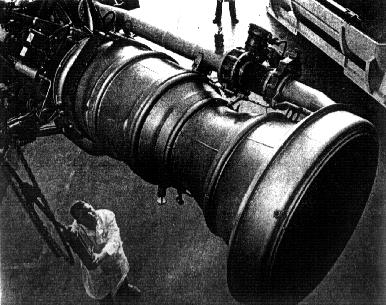
Home - Search - Browse - Alphabetic Index: 0- 1- 2- 3- 4- 5- 6- 7- 8- 9
A- B- C- D- E- F- G- H- I- J- K- L- M- N- O- P- Q- R- S- T- U- V- W- X- Y- Z
Lox/Hydyne

Redstone engine
Credit: NASA
Specific impulse: 359 s. Specific impulse sea level: 306 s.
Optimum Oxidizer to Fuel Ratio: 1.73. Temperature of Combustion: 3,585 deg K. Density: 1.02 g/cc. Oxidizer Density: 1.140 g/cc. Oxidizer Freezing Point: -219 deg C. Oxidizer Boiling Point: -183 deg C. Fuel Density: 0.860 g/cc. Fuel Freezing Point: -84 deg C. Fuel Boiling Point: 64 deg C.
| A-7 Rocketdyne LOx/Hydyne rocket engine. Out of Production. Version of Redstone engine for Jupiter-C test vehicle, with Hydyne fuel and 140 seconds burn time. Flew 1956-1959. Gas generator, pump-fed. Thrust 370 kN at sea level. |
| Jupiter C stage LOx/Hydyne propellant rocket stage. Redstone missile, stretched, modified with different propellants to serve as first stage of IRBM nose cone/orbital test vehicle. |
Engines: A-7. Stages: Jupiter C stage.
Back to top of page
Home - Search - Browse - Alphabetic Index: 0- 1- 2- 3- 4- 5- 6- 7- 8- 9
A- B- C- D- E- F- G- H- I- J- K- L- M- N- O- P- Q- R- S- T- U- V- W- X- Y- Z
© 1997-2019 Mark Wade - Contact
© / Conditions for Use